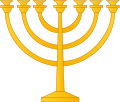
According to the Bible, Boaz (Hebrew : בֹּעַז , romanized: Bōʿaz) and Jachin (Hebrew : יָכִין , romanized: Yāḵīn) were two copper, brass or bronze pillars which stood on the porch of Solomon's Temple, the first Temple in Jerusalem. [1] They are used as symbols in Freemasonry and sometimes in religious architecture. They were probably not support structures but free-standing, based on similar pillars found in other nearby temples. [2]






